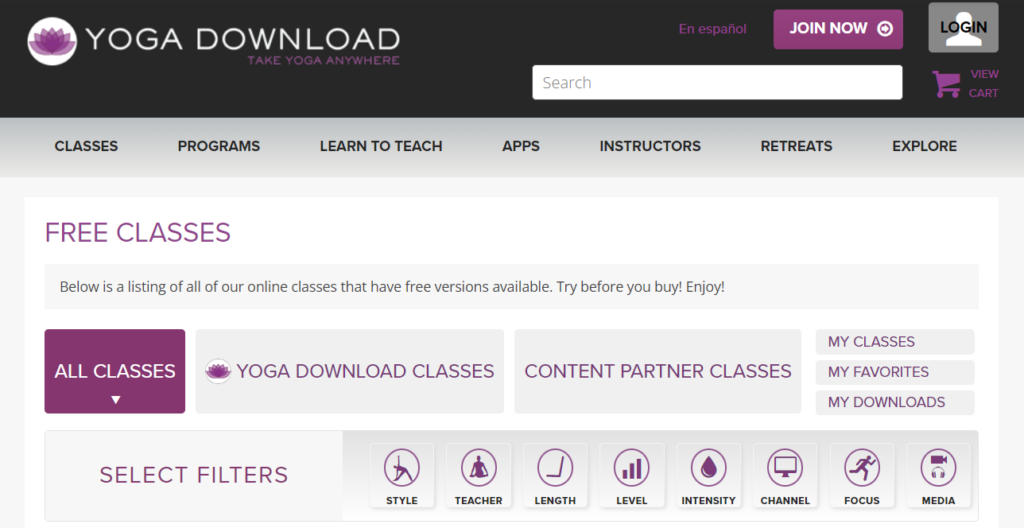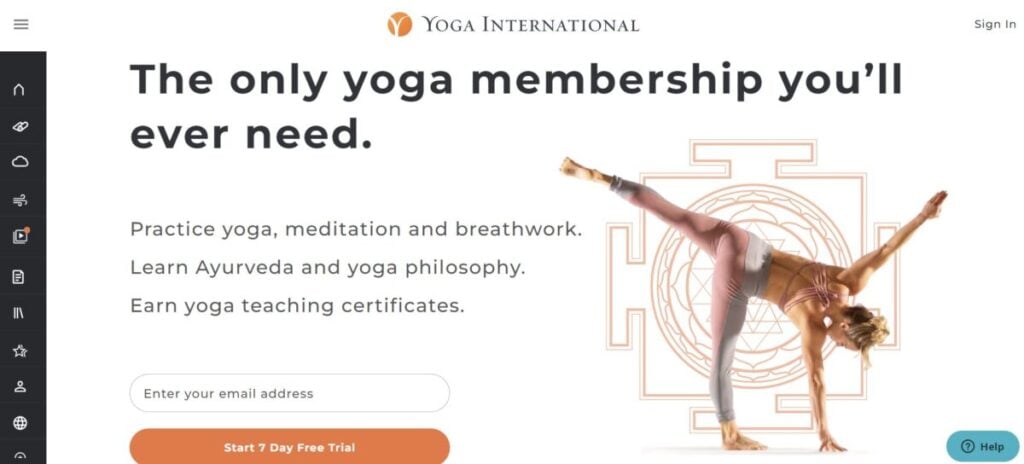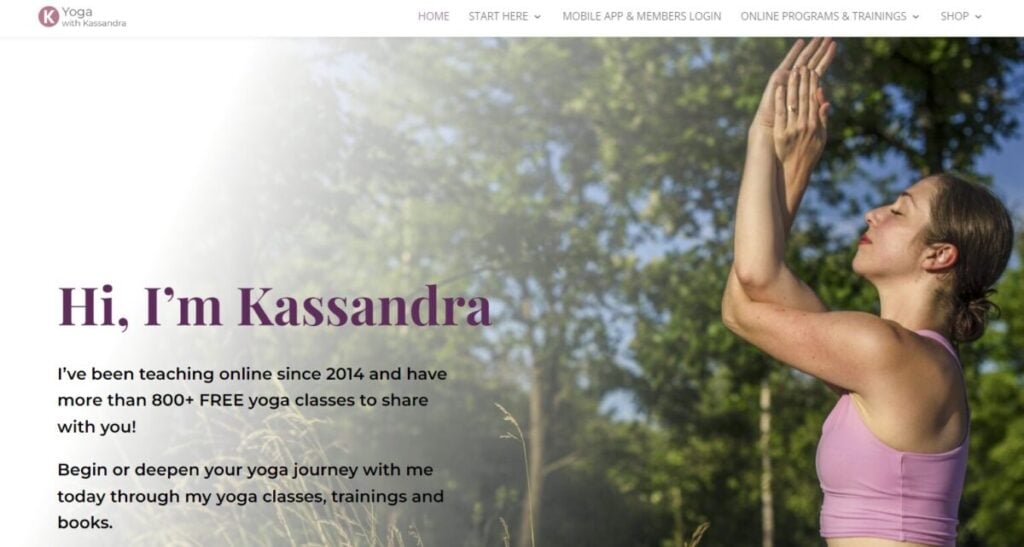Nowadays, increasingly more people are wearing yoga pants not just for comfort, but because they have actually joined a class. People from all walks of life are falling in love with yoga for the freedom and long list of benefits. Whether you want to tone or simply stress less, here are 20 of the top yoga classes you can join without leaving your home. The classes included in our list are aimed at beginners as well as more advanced yogis. Some of them are completely free, while others offer a free trial (and after trying it we are sure that you will not need to justify becoming a paid member).
- 1. Lululemon
- 2. Yoga with Adriene
- 3. Power Yoga
- 4. DoYogaWithMe
- 5. Fightmaster Yoga
- 6. Daily Burn
- 7. Recovery 2.0
- 8. Centr
- 9. CorePower Yoga On Demand
- 10. Yoga Download
- 11. Yoga International
- 12. YouAligned
- 13. Alo Moves
- 14. Gaia
- 15. ChriskaYoga
- 16. Tone It Up
- 17. SarahBethYoga
- 18. Five Parks Yoga
- 19. Brett Larkin – BrettLarkinYoga
- 20. Yoga with Kassandra
- Frequently Asked Questions
1. Lululemon

Founded in Vancouver, Canada more than 20 years ago, Lululemon is actually in the business of selling yoga-inspired athletic apparel for men and women. Though, on a weekly basis, they also live out their love for yoga by offering free yoga classes that are presented by instructors from local studios. Whether you are a beginner or more experienced, they offer a variety of free online yoga classes that include vinyasa yoga, restorative yoga, and power yoga.
They also have a comprehensive YouTube playlist where they publish various yoga videos covering both basic and advanced techniques.
2. Yoga with Adriene

Yoga with Adriene is a YouTube channel that is hosted by Adriene Mishler, an entrepreneur and international yoga teacher. Her online community already boasts more than 9 million subscribers and was recognized by Google as the most searched workout of 2015. To add to her list of accolades, she was also recognized as one of the 100 most influential people in health and fitness for two consecutive years. If you are a fan of following 30-day programs, Yoga with Adriene has a number of free 30-day journeys that you can follow.
3. Power Yoga

By becoming a Power Yoga member for free, you can gain limited access to featured classes and series. Whether you are simply in need of a short 10-minute meditation for anxiety or an hour-and-a-half class to help you experience more self-awareness and foster inner strength, Power Yoga offers a good selection of free classes.
4. DoYogaWithMe

DoYogaWithMe is a renowned online platform that specializes in yoga practices and educational materials for practitioners of all levels. It offers a vast collection of yoga videos, classes, and tutorials for everyone, from beginners to advanced practitioners. The site features a Free plan that provides access to a wide selection (500+ classes) of high-quality yoga content at no cost, making it an excellent resource for anyone looking to practice yoga at home.
5. Fightmaster Yoga

Fightmaster Yoga was led by the late Lesley Fightmaster. While the lady behind the popular videos is no longer with us, her videos are still available on the Fightmaster Yoga website. On this platform you will be able to find a wide range of videos that include yoga quickies, weight-loss yoga, prenatal yoga and yoga for flexibility and stretching.
6. Daily Burn

Just like Booya Fitness, Daily Burn offers a free 30-day trial. As the majority of mobile devices are not optimized for their site via a web browser, they took a different route and created the Daily Burn workout app. All you have to do is download the app, sign in using your credentials, and you are ready to start streaming the yoga workouts to your device. Though, sadly, it is currently available only on the Apple App Store.
7. Recovery 2.0

Every Wednesday morning, Tommy Rosen, teaches a live yoga class. Rosen is an addiction recovery expert and internationally acclaimed yoga teacher. In his classes, he concentrates on the power of breathing and movement to improve immunity, build vitality, and, ultimately, live optimally. While his classes are free, it is donation-based.
8. Centr

Founded by Chris Hemsworth (yes, the one and only), Centr offers a free 7-day trial. While it is not as long as some of the other free trials mentioned in our list, we bet that being able to say that you used the personalized digital health and fitness program curated by Thor will make up for it. Yoga classes are presented by Tahl Rinsky, an Australia-based instructor.
9. CorePower Yoga On Demand

Featured in Men’s Journal and Shape, CorePower Yoga boasts a community of almost 200 yoga studios. To access their collection of more than 300 yoga and meditation classes, you need to sign up for a subscription. Though, CorePower Yoga also offers a few free yoga classes. These prerecorded classes range from 20 minutes to 60 minutes.
10. Yoga Download

Yoga Download has a long list of free classes that you can download. Each free class has a rating and short description. Some of the classes are suitable for all levels, while others are more geared towards beginners or intermediates. What we like most about it is that it also indicates the intensity and props that you will need (something which few other classes actually do).
11. Yoga International

If you are a yoga teacher looking to sharpen your yoga skills without having to spend a cent, Yoga International is a good choice. While they offer monthly and annual membership options, they also have a free 7-day trial available. This trial will give you enough time to learn from their hundreds of expert instructors across all areas of yoga.
12. YouAligned

YouAligned has a rather unique selling proposition – for every yoga class that you take, they will plant a food-producing tree. Whether you have only 10 minutes available or you are able to set aside more than an hour, YouAligned has hundreds of classes available. They also offer themed full programs that consist of multiple classes with the aim of helping you reach a specific goal. While you need to sign up for a membership plan, they do offer a free 14-day trial.
13. Alo Moves

If you are specifically searching for prenatal yoga classes, be sure to check out Alo Moves. Briohny Smyth offers a series of classes for each stage of your pregnancy. While the classes are not free, she does offer a free 14-day trial.
14. Gaia

Gaia has received more than 9,863 reviews on Trustpilot. In addition to classes, they also have a collection of videos that focus on meditation and lifestyle. By signing up for their newsletter, you can access free videos. Alternatively, if you do not want to become a paid member, you can take advantage of their free 7-day trial.
15. ChriskaYoga

Hosted by Christina, the ChriskaYoga YouTube Channel was born in 2014 and boasts more than 115,000 subscribers. Every single week, on a Monday and Wednesday, she adds two free yoga classes to her channel. You can also follow her on Instagram for 30-day challenges.
16. Tone It Up

Katrina Scott and Karena Dawn are the two women behind Tone It Up. What started in 2009 as a fitness community with the aim of empowering women has grown into a successful brand that has been featured in Forbes, Business Insider, and Vogue. Their YouTube channel boasts close to 800,000 subscribers. Tone It Up offers numerous yoga videos to get your booty into shape.
17. SarahBethYoga

With nearly 2 million YouTube subscribers, 130,000+ Facebook followers and 100,000+ Instagram followers, Sarah Beth is one of the top Yoga influencers. As she has a background working as a chiropractic assistant, she ensures that functional movement is incorporated into all of her sequences. Another advantage is that she often shares short 10-minute videos on her YouTube channel, making it ideal for those with little time.
18. Five Parks Yoga

If your reason for starting yoga is to reduce stress and anxiety and not necessarily to tone, be sure to subscribe to the Five Parks Yoga’s YouTube channel that is hosted by Erin Sampson. While the channel does not have that many subscribers yet (that’s if you count more than 264,000 as a small crowd), it is a great place where you can find hundreds of free online yoga classes.
19. Brett Larkin – BrettLarkinYoga

Brett Larkin’s YouTube channel, BrettLarkinYoga, has received more than 46 million views to date. Here you will find hundreds of free yoga videos that mostly teach vinyasa flow yoga. Her Yoga Sculpt: Yoga for Arms and Upper Body, in particular, is a great workout to try. Whether you are a complete newbie or a more advanced yogi, you are bound to fall in love with this sweetheart and her successful brand.
20. Yoga with Kassandra

To make sure that you don’t skip leg day, Kassandra’s YouTube channel comes to the rescue. Her Yoga for Legs and Thighs Workout is best if you want to concentrate on your lower body. In her 20-minute routine, you will work on your hamstrings, glutes and thighs. She also shares free 30-day challenges if you are keen on making yoga part of your daily routine. Boasting more than 2 million subscribers, her YouTube channel is a great resource for free online vinyasa and yin yoga.
Frequently Asked Questions
Do I need any special equipment to participate in online yoga classes?
Most free online yoga classes can be done with minimal equipment. A yoga mat is generally recommended for comfort and support, but some classes may also suggest props like blocks, straps, or blankets. However, many classes can be adapted to what you have at home.
Is Brett Larkin good?
Brett Larkin is one of the top yoga influencers on YouTube and an award-winning yoga instructor. She boasts over a decade’s teaching experience, more than 550,000 subscribed students on YouTube and almost 10 years of experience in leading live online training. As she has already been teaching online for more than five years, she has already refined how to teach yoga classes online.
Are there any short online yoga classes for free?
If you are hard-pressed for time, Sarah Beth’s short yoga sessions are great. Her guided sessions range from rigorous workouts to meditation exercises. As she has a background working as a chiropractic assistant, she also ensures that functional movement is incorporated into all of her sequences. Moreover, she even has an app with 400+ videos!
How do I choose the right online yoga class for me?
Consider your experience level, preferred style of yoga, and any specific goals or needs you have. Many classes are labeled by difficulty level (beginner, intermediate, advanced) and focus area (e.g., flexibility, strength, relaxation). Read class descriptions and reviews to find one that fits your needs.
Do you need to be certified to teach yoga?
While you do not have to be certified to teach yoga, by completing a course that is accredited by the Yoga Alliance, it can open more doors for you. Also, considering that students will entrust you with their physical as well as mental well-being, it is important to stick to certain levels of standards and practices.


